2008 MERCEDES-BENZ CLS COUPE maintenance
[x] Cancel search: maintenancePage 7 of 329
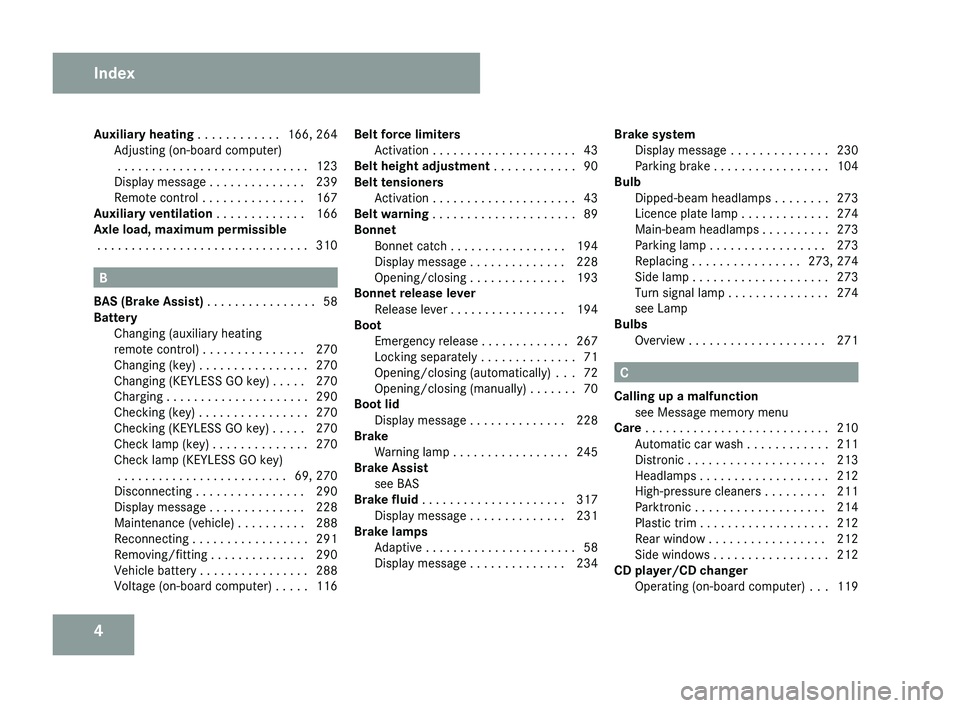
4
Auxiliary heating
. . . . . . . . . . . . 166, 264
Adjusting (on-board computer)
. . . . . . . . . . . . . . . . . . . . . . . . . . . . 123
Display message . . . . . . . . . . . . . . 239
Remote control . . . . . . . . . . . . . . . 167
Auxiliary ventilation . . . . . . . . . . . . . 166
Axle load, maximum permissible
. . . . . . . . . . . . . . . . . . . . . . . . . . . . . . . 310 B
BAS (Brake Assist)
. . . . . . . . . . . . . . . . 58
Battery Changing (auxiliary heating
remote control) . . . . . . . . . . . . . . . 270
Changing (key) . . . . . . . . . . . . . . . . 270
Changing (KEYLESS GO key) . . . . . 270
Charging . . . . . . . . . . . . . . . . . . . . . 290
Checking (key) . . . . . . . . . . . . . . . . 270
Checking (KEYLESS GO key) . . . . . 270
Check lamp (key) . . . . . . . . . . . . . . 270
Check lamp (KEYLESS GO key)
. . . . . . . . . . . . . . . . . . . . . . . . . 69, 270
Disconnecting . . . . . . . . . . . . . . . . 290
Display message . . . . . . . . . . . . . . 228
Maintenance (vehicle) . . . . . . . . . . 288
Reconnecting . . . . . . . . . . . . . . . . . 291
Removing/fitting . . . . . . . . . . . . . . 290
Vehicle battery . . . . . . . . . . . . . . . . 288
Voltage (on-board computer) . . . . . 116 Belt force limiters
Activation
. . . . . . . . . . . . . . . . . . . . . 43
Belt height adjustment . . . . . . . . . . . . 90
Belt tensioners Activation . . . . . . . . . . . . . . . . . . . . . 43
Belt warning . . . . . . . . . . . . . . . . . . . . . 89
Bonnet Bonnet catch . . . . . . . . . . . . . . . . . 194
Display message . . . . . . . . . . . . . . 228
Opening/closing . . . . . . . . . . . . . . 193
Bonnet release lever
Release lever . . . . . . . . . . . . . . . . . 194
Boot
Emergency release . . . . . . . . . . . . . 267
Locking separately . . . . . . . . . . . . . . 71
Opening/closing (automatically) . . . 72
Opening/closing (manually) . . . . . . . 70
Boot lid
Display message . . . . . . . . . . . . . . 228
Brake
Warning lamp . . . . . . . . . . . . . . . . . 245
Brake Assist
see BAS
Brake fluid . . . . . . . . . . . . . . . . . . . . . 317
Display message . . . . . . . . . . . . . . 231
Brake lamps
Adaptive . . . . . . . . . . . . . . . . . . . . . . 58
Display message . . . . . . . . . . . . . . 234 Brake system
Display message . . . . . . . . . . . . . . 230
Parking brake . . . . . . . . . . . . . . . . . 104
Bulb
Dipped-beam headlamps . . . . . . . . 273
Licence plate lamp . . . . . . . . . . . . . 274
Main-beam headlamps . . . . . . . . . . 273
Parking lamp . . . . . . . . . . . . . . . . . 273
Replacing . . . . . . . . . . . . . . . . 273, 274
Side lamp . . . . . . . . . . . . . . . . . . . . 273
Turn signal lamp . . . . . . . . . . . . . . . 274
see Lamp
Bulbs
Overview . . . . . . . . . . . . . . . . . . . . 271 C
Calling up a malfunction see Message memory menu
Care . . . . . . . . . . . . . . . . . . . . . . . . . . . 210
Automatic car wash . . . . . . . . . . . . 211
Distronic . . . . . . . . . . . . . . . . . . . . 213
Headlamps . . . . . . . . . . . . . . . . . . . 212
High-pressure cleaners . . . . . . . . . 211
Parktronic . . . . . . . . . . . . . . . . . . . 214
Plastic trim . . . . . . . . . . . . . . . . . . . 212
Rear window . . . . . . . . . . . . . . . . . 212
Side windows . . . . . . . . . . . . . . . . . 212
CD player/CD changer
Operating (on-board computer) . . . 119 Index
219_AKB; 2; 4, en-GB
mkalafa,
2007-11-13T09:28:36+01:00 - Seite 4
Page 12 of 329

9
Lights
Constant headlamp mode . . . . . . . . 92
Cornering light function . . . . . . . . . . 95
Dipped-beam headlamps . . . . . . . . . 92
Front foglamps . . . . . . . . . . . . . . . . . 93
Hazard warning lamps . . . . . . . . . . . 94
Headlamp flasher . . . . . . . . . . . . . . . 94
Headlamp range . . . . . . . . . . . . . . . . 95
Light switch . . . . . . . . . . . . . . . . . . . 91
Main-beam headlamps . . . . . . . . . . . 94
Rear foglamp . . . . . . . . . . . . . . . . . . 93
Switching off (display message) . . . 235
Turn signals . . . . . . . . . . . . . . . . . . . 94
LIM indicator lamp . . . . . . . . . . . . . . 133
Load compartment load, maximum
. . . . . . . . . . . . . . . . . . . . . . . . . . . . . . . 310
Loading guidelines . . . . . . . . . . . . . . 176
Locking Automatic . . . . . . . . . . . . . . . . . . . . . 69
Emergency locking . . . . . . . . . . . . . 267
From the inside (central locking
button) . . . . . . . . . . . . . . . . . . . . . . . 70
Luggage net . . . . . . . . . . . . . . . . . . . . 176
Lumbar support . . . . . . . . . . . . . . . . . . 78
Luxury head restraint . . . . . . . . . . 76, 77 M
Main-beam headlamps Display message
. . . . . . . . . . . . . . 235
Main fuse box . . . . . . . . . . . . . . . . . . . 296
Maintenance Battery . . . . . . . . . . . . . . . . . . . . . . 288
Malfunction memory
see Message memory menu
Manual gearshift program . . . . . . . . 108
Massage function (PULSE) . . . . . . . . . 80
Maximum speed Technical data . . . . . . . . . . . . . . . . 303
Memory card
Operation (on-board computer) . . . 119
Memory function . . . . . . . . . . . . . . . . . 86
Menu
DISTRONIC . . . . . . . . . . . . . . . . . . . 139
Menu (on-board computer) . . . . . . . . 114
AMG . . . . . . . . . . . . . . . . . . . . . . . . 116
Audio . . . . . . . . . . . . . . . . . . . . . . . 118
DVD . . . . . . . . . . . . . . . . . . . . . . . . 120
Message memory . . . . . . . . . . . . . . 121
Navigation . . . . . . . . . . . . . . . . . . . 120
Resetting to factory settings . . . . . 121
Settings . . . . . . . . . . . . . . . . . . . . . 121
Standard display . . . . . . . . . . . . . . 115
Submenu overview . . . . . . . . . . . . . 122
Telephone . . . . . . . . . . . . . . . . . . . 130 Trip computer
. . . . . . . . . . . . . . . . 129
TV . . . . . . . . . . . . . . . . . . . . . . . . . . 119
Message
see Message memory menu
Minispare emergency spare wheel
Storage location . . . . . . . . . . . . . . . 218
Technical data . . . . . . . . . . . . . . . . 308
Mirror
Sun visor . . . . . . . . . . . . . . . . . . . . 180
Mobile phone . . . . . . . . . . . . . . . . . . . 183
Bracket . . . . . . . . . . . . . . . . . . . . . 183
Display message . . . . . . . . . . . . . . 240
Installation . . . . . . . . . . . . . . . . . . . 299
Own number sending . . . . . . . . . . . 184
Run-on time . . . . . . . . . . . . . . . . . . 184
Telephone menu (on-board com-
puter) . . . . . . . . . . . . . . . . . . . . . . . 130
Modifying the programming
Key . . . . . . . . . . . . . . . . . . . . . . . . . . 66
KEYLESS GO key . . . . . . . . . . . . . . . 68
MOExtended run-flat system* . 199, 287
MP3 Operation (on-board computer) . . . 119
Multi-contour seat . . . . . . . . . . . . . . . . 79
Multi-function display . . . . . . . . 110, 112
Multi-function steering wheel . . . . . 111
Overview . . . . . . . . . . . . . . . . . . . . . 30 Index
219_AKB; 2; 4, en-GB
mkalafa,
2007-11-13T09:28:36+01:00 - Seite 9
Page 18 of 329
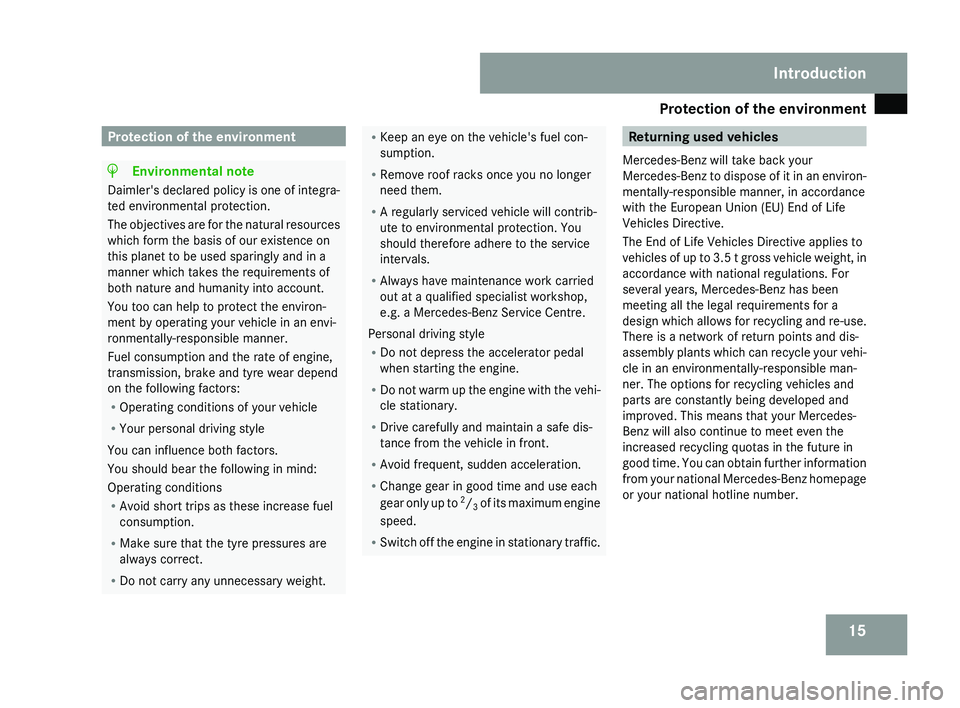
Protection of the environment
15Protection of the environment
H
Environmental note
Daimler's declared policy is one of integra-
ted environmental protection.
The
objectives are for the natural resources
which form the basis of our existence on
this planet to be used sparingly and in a
manner which takes the requirements of
both nature and humanity into account.
You too can help to protect the environ-
ment by operating your vehicle in an envi-
ronmentally-responsible manner.
Fuel consumption and the rate of engine,
transmission, brake and tyre wear depend
on the following factors:
R Operating conditions of your vehicle
R Your personal driving style
You can influence both factors.
You should bear the following in mind:
Operating conditions
R Avoid short trips as these increase fuel
consumption.
R Make sure that the tyre pressures are
always correct.
R Do not carry any unnecessary weight. R
Keep an eye on the vehicle's fuel con-
sumption.
R Remove roof racks once you no longer
need them.
R A regularly serviced vehicle will contrib-
ute to environmental protection. You
should therefore adhere to the service
intervals.
R Always have maintenance work carried
out at a qualified specialist workshop,
e.g. a Mercedes-Benz Service Centre.
Personal driving style
R Do not depress the accelerator pedal
when starting the engine.
R Do
not warm up the engine with the vehi-
cle stationary.
R Drive carefully and maintain a safe dis-
tance from the vehicle in front.
R Avoid frequent, sudden acceleration.
R Change gear in good time and use each
gear only up to 2
/ 3 of its maximum engine
speed.
R Switch off the engine in stationary traffic. Returning used vehicles
Mercedes-Benz will take back your
Mercedes-Benz
to dispose of it in an environ-
mentally-responsible manner, in accordance
with the European Union (EU) End of Life
Vehicles Directive.
The End of Life Vehicles Directive applies to
vehicles of up to 3.5 t gross vehicle weight, in
accordance with national regulations. For
several years, Mercedes-Benz has been
meeting all the legal requirements for a
design which allows for recycling and re-use.
There is a network of return points and dis-
assembly plants which can recycle your vehi-
cle in an environmentally-responsible man-
ner. The options for recycling vehicles and
parts are constantly being developed and
improved. This means that your Mercedes-
Benz will also continue to meet even the
increased recycling quotas in the future in
good time. You can obtain further information
from your national Mercedes-Benz homepage
or your national hotline number. Introduction
219_AKB; 2; 4, en-GB
mkalafa,
2007-11-13T09:28:36+01:00 - Seite 15
Page 45 of 329
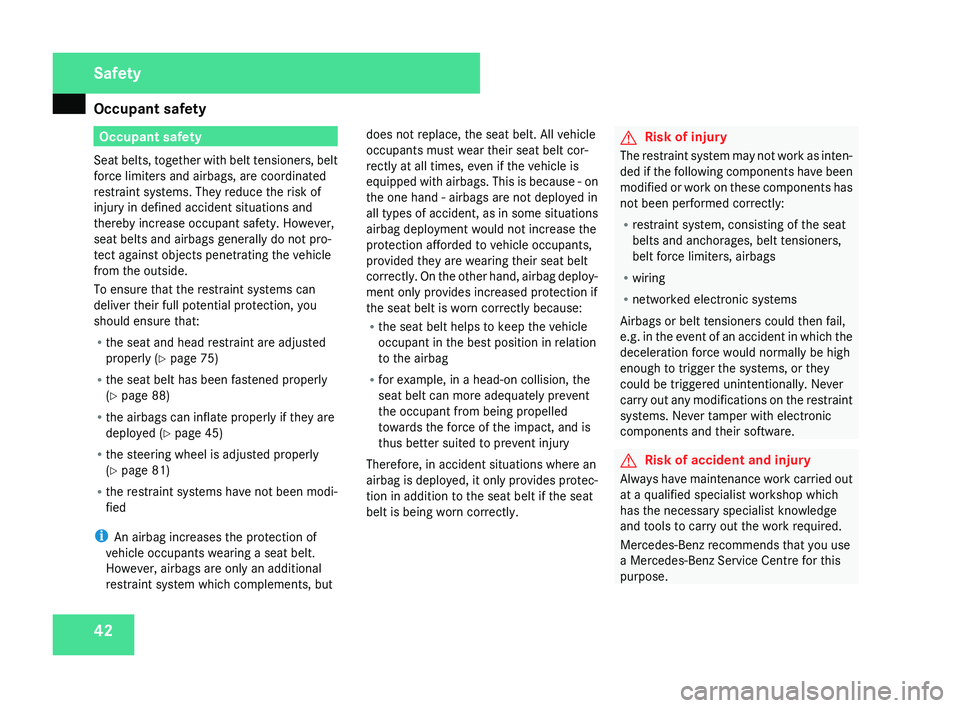
Occupant safety
42 Occupant safety
Seat belts, together with belt tensioners, belt
force limiters and airbags, are coordinated
restraint systems. They reduce the risk of
injury in defined accident situations and
thereby increase occupant safety. However,
seat belts and airbags generally do not pro-
tect against objects penetrating the vehicle
from the outside.
To ensure that the restraint systems can
deliver their full potential protection, you
should ensure that:
R the seat and head restraint are adjusted
properly ( Y page 75)
R the seat belt has been fastened properly
(Y page 88)
R the airbags can inflate properly if they are
deployed ( Y page 45)
R the steering wheel is adjusted properly
(Y page 81)
R the restraint systems have not been modi-
fied
i An airbag increases the protection of
vehicle occupants wearing a seat belt.
However, airbags are only an additional
restraint system which complements, but does not replace, the seat belt. All vehicle
occupants must wear their seat belt cor-
rectly at all times, even if the vehicle is
equipped
with airbags. This is because - on
the one hand - airbags are not deployed in
all types of accident, as in some situations
airbag deployment would not increase the
protection afforded to vehicle occupants,
provided they are wearing their seat belt
correctly. On the other hand, airbag deploy-
ment only provides increased protection if
the seat belt is worn correctly because:
R the seat belt helps to keep the vehicle
occupant in the best position in relation
to the airbag
R for example, in a head-on collision, the
seat belt can more adequately prevent
the occupant from being propelled
towards the force of the impact, and is
thus better suited to prevent injury
Therefore, in accident situations where an
airbag is deployed, it only provides protec-
tion in addition to the seat belt if the seat
belt is being worn correctly. G
Risk of injury
The restraint system may not work as inten-
ded
if the following components have been
modified or work on these components has
not been performed correctly:
R restraint system, consisting of the seat
belts and anchorages, belt tensioners,
belt force limiters, airbags
R wiring
R networked electronic systems
Airbags or belt tensioners could then fail,
e.g. in the event of an accident in which the
deceleration force would normally be high
enough to trigger the systems, or they
could be triggered unintentionally. Never
carry out any modifications on the restraint
systems. Never tamper with electronic
components and their software. G
Risk of accident and injury
Always have maintenance work carried out
at a qualified specialist workshop which
has the necessary specialist knowledge
and tools to carry out the work required.
Mercedes-Benz recommends that you use
a Mercedes-Benz Service Centre for this
purpose. Safety
219_AKB; 2; 4, en-GB
mkalafa,
2007-11-13T09:28:36+01:00 - Seite 42
Page 223 of 329
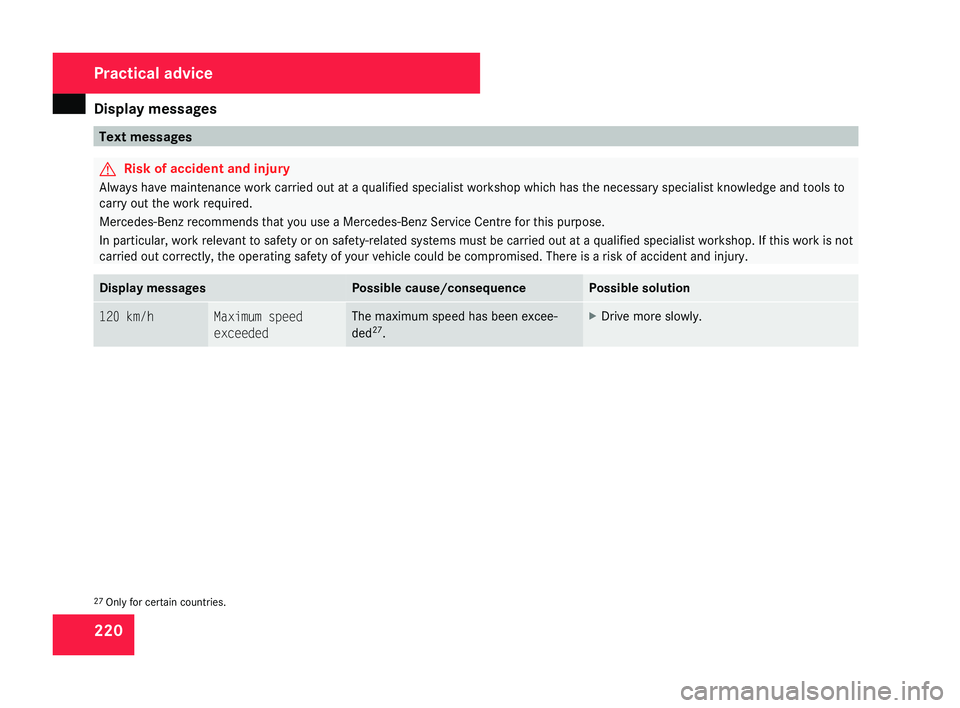
Display messages
220 Text messages
G
Risk of accident and injury
Always have maintenance work carried out at a qualified specialist workshop which has the necessary specialist knowledge and tools to
carry out the work required.
Mercedes-Benz recommends that you use a Mercedes-Benz Service Centre for this purpose.
In
particular, work relevant to safety or on safety-related systems must be carried out at a qualified specialist workshop. If this work is not
carried out correctly, the operating safety of your vehicle could be compromised. There is a risk of accident and injury. Display messages Possible cause/consequence Possible solution
120 km/h Maximum speed
exceeded The maximum speed has been excee-
ded
27
. X
Drive more slowly. 27
Only for certain countries. Practical advice
219_AKB; 2; 4, en-GB
mkalafa,
2007-11-13T09:28:36+01:00 - Seite 220
Page 231 of 329
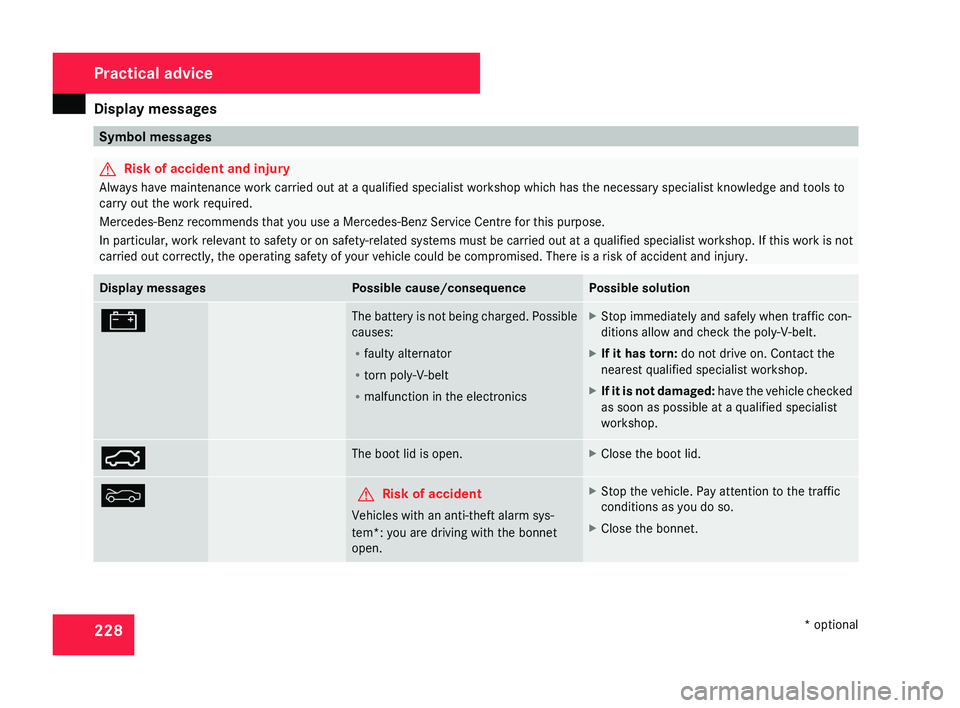
Display messages
228 Symbol messages
G
Risk of accident and injury
Always have maintenance work carried out at a qualified specialist workshop which has the necessary specialist knowledge and tools to
carry out the work required.
Mercedes-Benz recommends that you use a Mercedes-Benz Service Centre for this purpose.
In
particular, work relevant to safety or on safety-related systems must be carried out at a qualified specialist workshop. If this work is not
carried out correctly, the operating safety of your vehicle could be compromised. There is a risk of accident and injury. Display messages Possible cause/consequence Possible solution
# The battery is not being charged. Possible
causes:
R
faulty alternator
R torn poly-V-belt
R malfunction in the electronics X
Stop immediately and safely when traffic con-
ditions allow and check the poly-V-belt.
X If it has torn: do not drive on. Contact the
nearest qualified specialist workshop.
X If it is not damaged:
have the vehicle checked
as soon as possible at a qualified specialist
workshop. Ê The boot lid is open. X
Close the boot lid. Y G
Risk of accident
Vehicles with an anti-theft alarm sys-
tem*: you are driving with the bonnet
open. X
Stop the vehicle. Pay attention to the traffic
conditions as you do so.
X Close the bonnet. Practical advice
* optional
219_AKB; 2; 4, en-GB
mkalafa,
2007-11-13T09:28:36+01:00 - Seite 228
Page 244 of 329
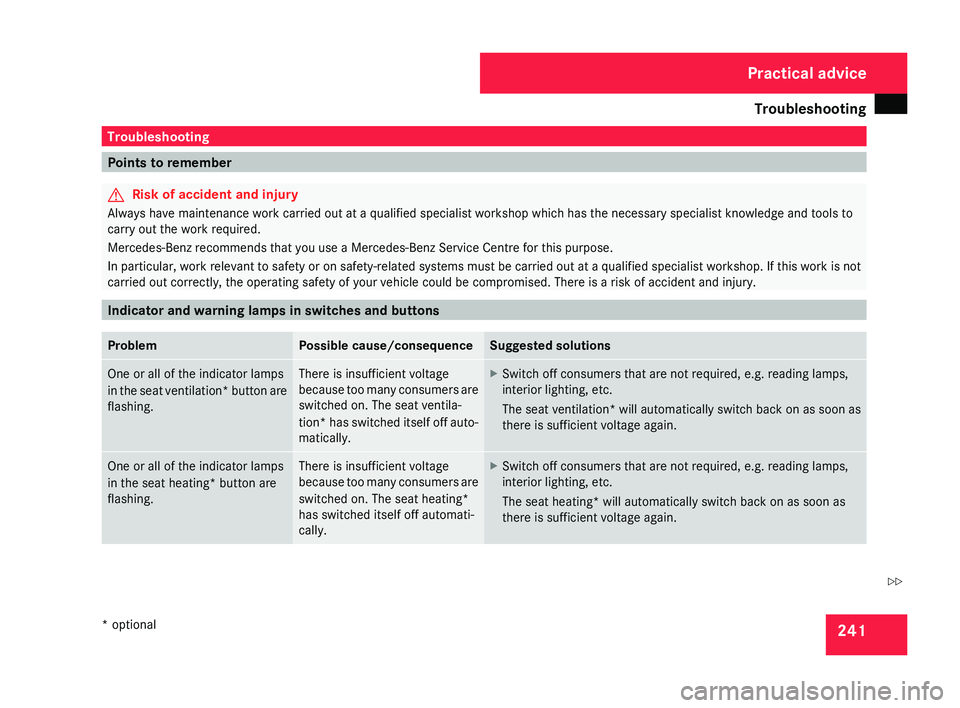
Troubleshooting
241Troubleshooting
Points to remember
G
Risk of accident and injury
Always have maintenance work carried out at a qualified specialist workshop which has the necessary specialist knowledge and tools to
carry out the work required.
Mercedes-Benz recommends that you use a Mercedes-Benz Service Centre for this purpose.
In
particular, work relevant to safety or on safety-related systems must be carried out at a qualified specialist workshop. If this work is not
carried out correctly, the operating safety of your vehicle could be compromised. There is a risk of accident and injury. Indicator and warning lamps in switches and buttons
Problem Possible cause/consequence Suggested solutions
One or all of the indicator lamps
in
the seat ventilation* button are
flashing. There is insufficient voltage
because
too many consumers are
switched on. The seat ventila-
tion* has switched itself off auto-
matically. X
Switch off consumers that are not required, e.g. reading lamps,
interior lighting, etc.
The seat ventilation*
will automatically switch back on as soon as
there is sufficient voltage again. One or all of the indicator lamps
in the seat heating* button are
flashing. There is insufficient voltage
because
too many consumers are
switched on. The seat heating*
has switched itself off automati-
cally. X
Switch off consumers that are not required, e.g. reading lamps,
interior lighting, etc.
The seat heating* will automatically switch back on as soon as
there is sufficient voltage again. Practical advice
* optional
219_AKB; 2; 4, en-GB
mkalafa,
2007-11-13T09:28:36+01:00 - Seite 241 Z